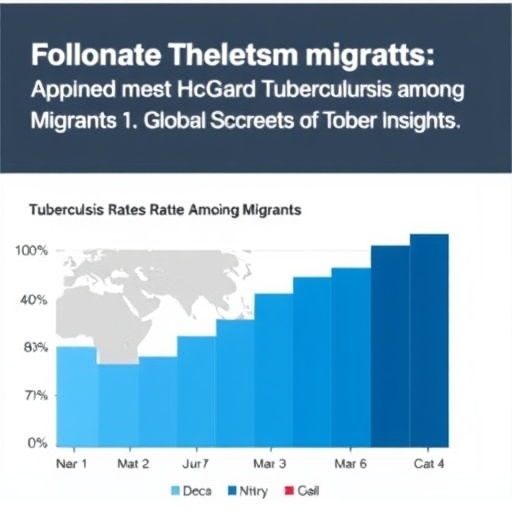In a world increasingly marked by global migration, understanding the health challenges faced by mobile populations has never been more critical. A groundbreaking study recently published in Global Health Research and Policy illuminates the ongoing battle against tuberculosis (TB) among migrants, a subject that resonates deeply across borders and healthcare systems alike. The research, a comprehensive systematic review and meta-analysis conducted by Chen, Ren, Liu, and colleagues, offers an unprecedented synthesis of data from national screening programs worldwide, revealing the alarming prevalence of TB within migrant communities and the urgent need for informed policy responses.
Tuberculosis, an ancient scourge, remains one of the world’s deadliest infectious diseases, disproportionately affecting vulnerable populations. Migrants face unique risk factors due to their often precarious living and working conditions, disrupted healthcare access, and the varying TB burdens of their countries of origin and destination. Despite extensive efforts by health authorities globally, TB prevalence among migrants continues to represent a persistent public health challenge, underscoring the importance of systematic screening programs as frontline interventions.
The study meticulously aggregated data from numerous national tuberculosis screening initiatives targeting migrant populations, spanning multiple continents and diverse demographic contexts. The researchers applied rigorous inclusion criteria ensuring the reliability and comparability of findings, thereby enabling an accurate estimation of infection rates and associated risk factors among migrants. By employing meta-analytic techniques, the authors generated pooled prevalence estimates that elucidate the extent of TB exposure and active cases in these often-overlooked groups.
One of the most striking revelations of the analysis is that the global prevalence of tuberculosis among migrants in national screening programs remains disturbingly high, with rates far exceeding those observed in the general population. This disparity reflects a complex interplay of social determinants and epidemiological realities. Migrant populations are frequently subject to crowded living conditions, poor nutrition, psychosocial stressors, and limited access to preventive and curative healthcare services—all factors that potentiate TB transmission and progression.
Furthermore, the review highlights significant heterogeneity in TB prevalence across different migrant groups, influenced by their country of origin, migration trajectory, and host country policies. For instance, migrants arriving from high-incidence regions such as parts of Sub-Saharan Africa and Southeast Asia demonstrated notably higher TB rates compared to those from countries where TB is less endemic. The heterogeneity extends to screening protocols themselves, which vary widely in scope, methodology, and follow-up care, impacting the detection and management of TB cases.
The authors emphasize the critical role of early detection and treatment adherence in curbing tuberculosis transmission among migrants. National screening programs, when systematically implemented, serve as essential tools to identify latent and active TB cases before widespread community transmission occurs. However, the study draws attention to the limitations posed by inconsistencies in screening coverage, diagnostic accuracy, and post-screening interventions, which can undermine the ultimate effectiveness of these programs.
In examining diagnostic strategies, the study discusses the use of chest radiography, interferon-gamma release assays (IGRAs), tuberculin skin tests (TST), and molecular diagnostic tools within migrant screening frameworks. Each technique carries inherent advantages and challenges. For example, radiography offers rapid detection of active lung TB but requires infrastructure and expert interpretation. IGRAs and TSTs detect latent TB infection but may yield false positives or negatives influenced by prior Bacillus Calmette-Guérin (BCG) vaccination status or immune suppression.
Notably, the meta-analysis underscores substantial gaps in follow-up and treatment completion rates among migrants diagnosed with TB. Barriers including language difficulties, fear of deportation, unstable housing, and economic constraints contribute to treatment interruptions, which in turn fuel drug resistance and ongoing transmission. The study advocates for culturally sensitive healthcare models and enhanced social support services tailored to migrant populations, highlighting these as pivotal components of effective TB control strategies.
The research further identifies a pressing need for international collaboration and policy harmonization. Given the transnational nature of migration, a patchwork of disparate national responses can limit the global impact of TB control efforts. The authors call for standardized protocols and data-sharing agreements that transcend borders, allowing for more seamless management of TB cases throughout migration journeys and improving surveillance accuracy.
The public health implications of these findings are profound. Migrant health programs must balance the imperatives of safeguarding community health with the protection of individual rights and dignity. Screening initiatives should avoid stigmatization and ensure confidentiality, fostering trust and engagement within migrant communities. Moreover, investment in comprehensive healthcare access for migrants aligns with broader goals of health equity and social justice, reinforcing the societal benefits of integrated TB control.
Technological advancements offer promising avenues to enhance screening efficacy. The study points to emerging digital tools for remote diagnosis, mobile health applications facilitating treatment adherence, and machine learning algorithms capable of refining risk stratification and outbreak prediction. Harnessing such innovations, combined with traditional public health measures, may revolutionize TB management among migrants.
In conclusion, Chen, Ren, Liu, and colleagues’ systematic review and meta-analysis provide a vital, data-driven perspective on the enduring challenges of tuberculosis control in a migratory world. Their insights call for urgent, coordinated action that bridges epidemiology, clinical medicine, and policy to reduce TB vulnerabilities among migrants. As migration flows continue to shape global demographics, addressing the nexus of mobility and infectious disease becomes not only a medical imperative but a defining issue of our time.
Subject of Research: Tuberculosis prevalence among migrants under national screening programs
Article Title: Prevalence of Tuberculosis among migrants under national screening programs: a systematic review and meta-analysis
Article References:
Chen, Q., Ren, N., Liu, S. et al. Prevalence of Tuberculosis among migrants under national screening programs: a systematic review and meta-analysis. Global Health Research and Policy 10, 24 (2025). https://doi.org/10.1186/s41256-025-00424-y
Image Credits: AI Generated




